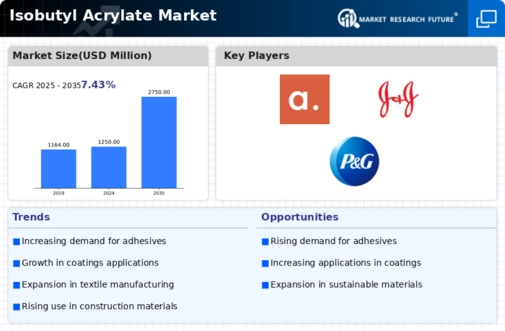Isobutyl Acrylate Size
Isobutyl Acrylate Market Growth Projections and Opportunities
Regulatory factors and environmental issues have got a great influence on Isobutyl Acrylate market. As a crucial component in paintings and glues, there are regulatory standards for product safety and environmental friendliness that must be met while using Isobutyl Acrylate. Manufacturers have to comply with these standards to be legally operational and meet environmentally conscious customers’ expectations. The increasing demand for sustainable alternatives in this sector has also resulted into industry efforts towards development of low-VOC formulations.
The global economic environment is one of the key determinants of how business is conducted within the market for Isobutyl Acrylates. The demand for products having Isobutyl Acrylate directly depends on economic conditions including construction activities, automotive production as well as manufacturing consumer goods. Economic expansions often entail increased focus on durable materials with enhanced performance capabilities implying spiked uptake of acrylates like IBA. However, certain industries may get hit during economic recessions thus impacting negatively on market dynamics.
Technology advancement within acrylic chemistry makes a considerable contribution to the growth rate experienced by this niche in terms today’s marketspace trends about this chemical compound. Improvements in synthesis methods, polymerization options along with functional modifications can enable better performance characteristics such as versatility or applicability when it comes to Isobutyl Acrylates. Businesses engaging in research and development as a way of staying ahead technologically are in a better position to meet changing industry demands and remain competitive within the Isobutyl Acrylate market.
For the Isobutyl Acrylate market, supply chain dynamics relating to raw material availability and pricing are critical factors. Typical components for making Isobutyl Acrylate are isobutanol and acrylic acid primarily as raw materials. Variations in prices of these raw materials will impact on overall production costs thus affecting the Isobutyl Acrylate market characteristics. Continuity of supply from manufacturers through good logistics ensures that there is no shortage of this component thus maintaining equilibrium.
The global trade policies and geopolitical factors also affect the Isobutyl Acrylates marketspace. Tariffs, trade agreements’ stipulations, or simply geopolitical tensions may have an impact on chemical movement across nations impacting both sides of exchange. To successfully navigate such external companies operating in this space must be conversant with global trade dynamics.
To a large extent, competitive forces within the IBA sector emanate from major players; their market share plus strategic moves they make. Many organizations concentrate on product innovation and diversify their offerings through mergers while others enter into strategic alliances so that they can become key players in this industry. Typically, speciality chemical producers like those dealing with Isobutyl Acrylates commonly apply mergers and acquisitions as growth strategies to enhance their competitive edge."







Leave a Comment